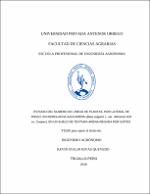Estudio del número de líneas de plantas, por lateral de riego, en remolacha azucarera (Beta vulgaris L. var. Altissima Döll cv. Cooper); en un suelo de textura arena regada por goteo

View/
Download
(application/pdf: 4.303Mb)
(application/pdf: 4.303Mb)
Date
2019Author(s)
Rivas Quevedo, Kevin Stalin
Metadata
Show full item recordAbstract
La presente investigación se desarrolló en los campos de la empresa Agro
Industrial UPAO S.A.C, en la provincia de Trujillo, en el departamento de
La Libertad, entre los meses de junio y diciembre del año 2017 con una
duración de 170 días calendario. El cultivar usado fue Cooper. El sistema
de riego fue por goteo en un suelo de textura arena. Esta investigación se
realizó con el objetivo principal de determinar la eficiencia de un solo lateral
de riego para diferentes líneas de plantas a diferentes distanciamientos,
pero con la misma densidad de siembra. El sistema de siembra fue manual,
tres bolillos, se tuvo un solo experimento con cuatro tratamientos; dos
líneas de plantas a 11 cm, tres líneas de plantas a 17 cm, cuatro líneas de
plantas a 22 cm y cinco líneas de plantas a 28 cm respectivamente con una
densidad de muy aproximadamente de 100 000 plantas por hectárea.
Realizados los análisis correspondientes no se encontraron diferencias
significativas entre los tratamientos en cuanto a germinación. Se determinó
que es necesario un solo lateral de riego para cinco líneas de plantas. Los
análisis de calidad fueron similares en todos los tratamientos y la
producción fue mayor en el tratamiento con cinco líneas de plantas,
habiendo una diferencia de 29.54 t.ha-1 entre el primer y cuarto tratamiento.
Todas las plantas se vieron severamente afectadas por ataque de
nematodos, desde las primeras semanas hasta el día de la cosecha, pero
aun así prosperó, con muy buenos rendimientos, donde otro cultivo no
hubiera podido desarrollarse. This investigation was developed at Agro Industrial UPAO S.A.C, in the
province of Trujillo, in La Libertad, between the months of June and
December, with a duration of 170 days. Cooper, was used cultivar. Drip
irrigation was utilized on a sand texture floor. This research was carried out
with the main objective of determining the efficiency of a single irrigation
latheral for different plant lines at different distances, but with the same
density of planting. The planting system was manual, there was only one
experiment with four treatments, two lines of plants at 11cm, three lines of
plants at 17cm, four lines of plants at 22cm and five lines of plants at 28cm
respectively, with approximately 100 000 plants per hectare.
No significant differences were found between treatments about
germination. It was found that a single irrigation latheral was necessary for
five plant lines. Quality analysis were similar in all treatments and production
was higher in the treatment with five plant lines, with a difference of 29.54
t.ha between the first and fourth treatment.
All plants were severely affected by nematode attack, from the first week to
the day of harvest, but still thrived with very good yields, where another crop
could not have developed.
Collections
- Ingeniería Agrónoma [99]

